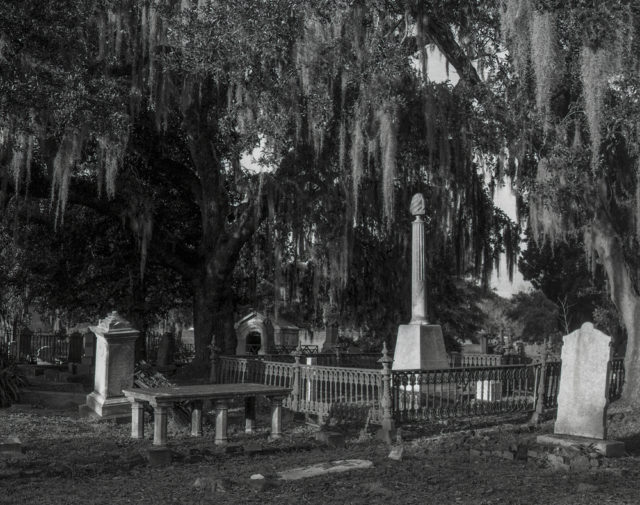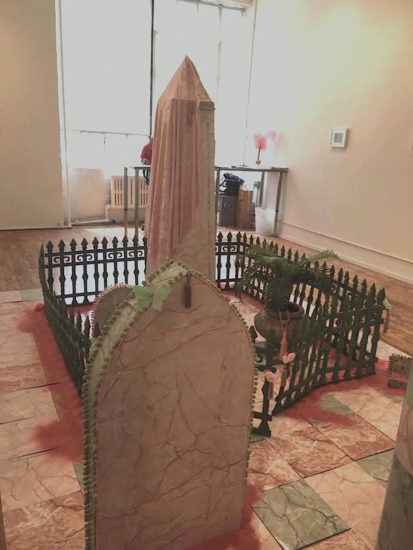
Rachel Stern, Magnolia Cemetery, Charleston, 2016, Silver Gelatin (Courtesy Rachel Stern and Black & White Gallery/Project Space)
Rachel Stern: Yes, Death
Black & White Gallery/Project Space
56 Bogart Street, Brooklyn, NY
On view until July 31, 2016
Why does the division between life and death always seem narrower in the American South? Maybe it’s the prevalence of ghost stories or just the spooky imagery of Spanish moss hanging from a live oak tree.
Rachel Stern delves into this tenuous Southern boundary between life and death in her current solo exhibition Yes, Death at Black & White Gallery/Project Space. And what could be more emblematic of the transition into the afterlife than cemeteries?
Yes, Death, curated by Sasha Okshteyn, presents Stern’s ongoing interest in the theatrical and heavily constructed rural or garden cemetery. Emerging in the mid-19th century in the United States, this popular cemetery style features winding paths, monumental marble memorials, eerie angelic sculptures and vast areas of well-tended gardens. Their architects envisioned a space that was equally for the living and the dead, inviting long strolls, picnics and more recently, tacky guided tours.
Pursuing her fascination with garden cemeteries (as seen on her Instagram #MsRSChurchNGrave),Yes, Death displays a series of small, somber black-and-white photographs of historic cemeteries in the South. Stern was awarded a travel grant from Columbia, which allowed her to document storied cemeteries like Magnolia in Charleston, South Carolina and Bonaventure in Savannah, Georgia. In addition to the photographs lining the walls, the show also presents a central pastel installation designed to reflect the architecture of rural cemeteries.

Installation view of Rachel Stern’s Yes, Death at Black & White Gallery/Project Space (photo by author)
The exhibition’s title originates from a wistful quote by Oscar Wilde, which provides insight into Stern’s cemetery obsession. Wilde said, “Yes, death. Death must be so beautiful. To lie in the soft brown earth, with the grasses waving above one’s head, and listen to silence. To have no yesterday and no tomorrow. To forget time, to forget life, to be at peace.” Similar to Wilde’s proclamation, garden cemeteries–for Stern–represent an acceptance of death as welcome and maybe even, aesthetically pleasing.
Primarily a studio photographer, Stern’s photographs in Yes, Death represent a surprising artistic departure. Her typical work is vibrantly colored and elaborately staged, as evidenced by her portraits that combine classical poses and art historical references with decadent velvet backgrounds and campy props. [Full disclosure: Stern also worked on AFC’s 2015 Panda Calendar–a project that neither this author nor editor were involved with.] Compared to the enduring sense of absurdity in her previous photography, Stern’s cemetery pictures seem conventional and almost conservative.

Rachel Stern, Magnolia Cemetery, Charleston, 2016, Silver Gelatin (Courtesy Rachel Stern and Black & White Gallery/Project Space)
This doesn’t mean they aren’t beautiful. Stern’s photographs record the haunted mystery of the Southern landscape with its drooping trees and overgrown foliage. With graves and monuments creepily rising from the vegetation, her images exude a Gothic romanticism that is more Flannery O’Connor than Hot Topic. The stark landscapes–perhaps due to their absence of figures–feel out of time. The pictures are reminiscent of photographer Clarence John Laughlin’s 1940’s publication Ghosts Along the Mississippi, a touchpoint that you wouldn’t necessarily expect to find from a young artist. Laughlin’s well-known photography book captures the ruins of Louisiana’s decadent and desolate plantations and graveyards before they became the sightseeing destinations of today.
Laughlin’s photographs also reveal what Stern’s are lacking–an engagement with the fraught history of the South. An alternative narrative of slavery runs parallel to the development of garden-style cemeteries in Southern cities. Many of the cemeteries documented, including Bonaventure and Magnolia, are built on sites of former plantations. They are also filled with the graves of important generals and administrators from the Confederacy. And yet, this goes completely unmentioned in the exhibition, press release or Stern’s artist statement.
With her careful attention to architecture and horticulture in her photos, Stern’s interest unquestionably lies with aesthetics rather than history. However, that doesn’t feel like enough in 2016 when the United States is still visibly and violently dealing with the repercussions of systemic racism and subjugation.

Detail of Rachel Stern’s Yes, Death at Black & White Gallery/Project Space (photo by author)
What saves Yes, Death from becoming a completely nostalgic vision of the American South is Stern’s candy-colored sculptural installation. Her site-specific installation is a cemetery turned kitsch with faux marble pillars, headstones, fake flowers, little fuzzy trimmings and even, a shimmery fabric butterfly. Similar to Langdon Graves’ cheery interpretation of ghost stories in Spooky Action At A Distance, Stern transforms death into an adorable tableau. She writes in her artist statement, “Yes, death is grim, but it’s also kinda cute.” While physical death itself may not be cute per se (despite her assertion), the aesthetic structures around death, such as tending flowers at a gravesite, can have a distinctive sweetness.
Stern’s installation brings death to the everyday experience of an average art viewer, albeit with whimsical craft store materials rather than granite and marble. By constructing a graveyard in a gallery, she invites New York art viewers to consider our own relationship to death. In general, Western culture doesn’t share the same intimate relationship with death that some other cultures do. In response to this detachment from mortality, Stern brings the cemetery to us.
Stern’s installation and its plea for an increased intimacy with death reminded me of a discussion on our contemporary relation to death in Rebecca Mead’s New Yorker article “Our Bodies, Ourselves.” Mead interviews funeral director Caitlin Doughty, who is best known for her “Ask A Mortician” webseries. Addressing the distance most Americans have with death, Doughty explains, “When I first thought I wanted to get into the industry, I thought people needed a more friendly death–for death to be more accessible. That changed very quickly. Now I think people need to get closer to it.” Like Doughty, Stern’s Yes, Death encourages the viewer to get closer with death whether in her Bushwick gallery graveyard or in a Southern garden cemetery.


Comments on this entry are closed.